
Belarus (Byelorussia)
For a full scale picture, please click on the picture shown !
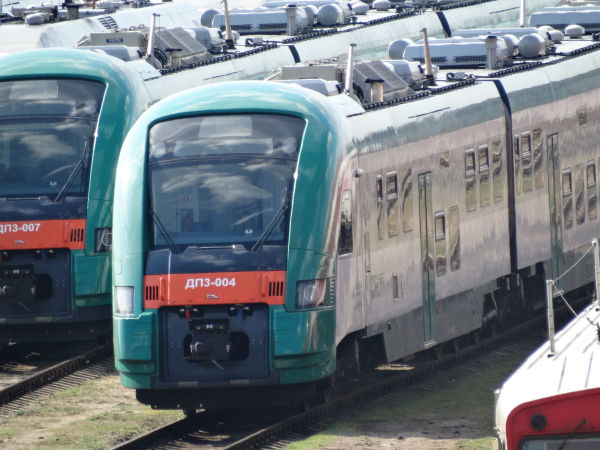
New class DP3 diesel multiple units of the Belarusian state railways. Belarusian and Lithuanian state railways run jointly the
route Vilnius - Minsk four times a day, two with Lithuanian trains and two with Belarusian trains. The Belarusian trains are these
brand new DP3 diesels. They are built by Pesa in Poland. Picture 2.4.2017 in Vilnius by Ilkka Siissalo.
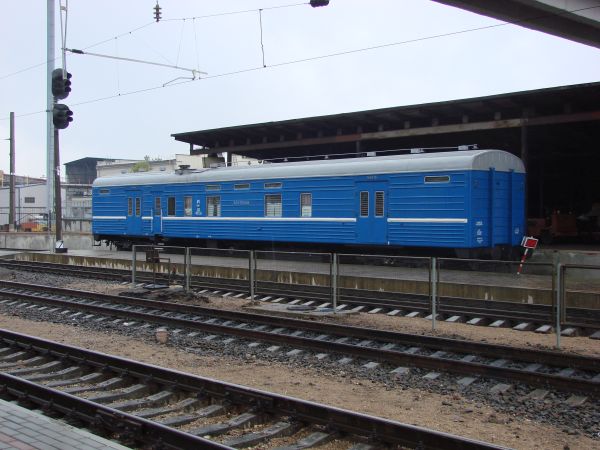
In older times passenger traffic between Vilnius in Lithuania and Minsk in Belarus took place using traditional Soviet Russian
express train coaches. This is a postal wagon of such a train, owned by BCh, Belarus state railways. Picture in Vilnius, Lithuania 15.9.2007 by Ilkka Siissalo.
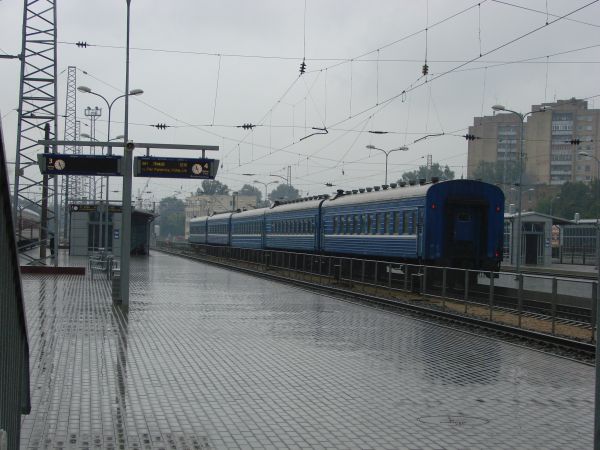
This was the whole passenger train of Belarus railways in 2007, here soon ready to leave towards Minsk. Picture in Vilnius, Lithuania
15.9.2007 by Ilkka Siissalo.
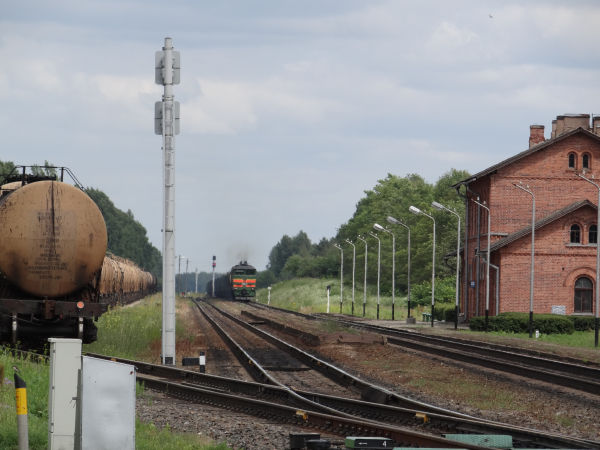
There is frequent and heavy cargo traffic from Belarus right through Latvia and Lithuania to and from the Latvian and Lithuanian Baltic
Sea ports. Much of this traffic is run by Belarusian trains. Here a Belarusian state railways old giant of the class 2TE10M is just
approaching the Latvian small station of Naujene. On the left an empty Russian crude oil train en route back to Russia via Latvia and
Belarus. Picture in Naujene 27.6.2013 by Ilkka Siissalo.
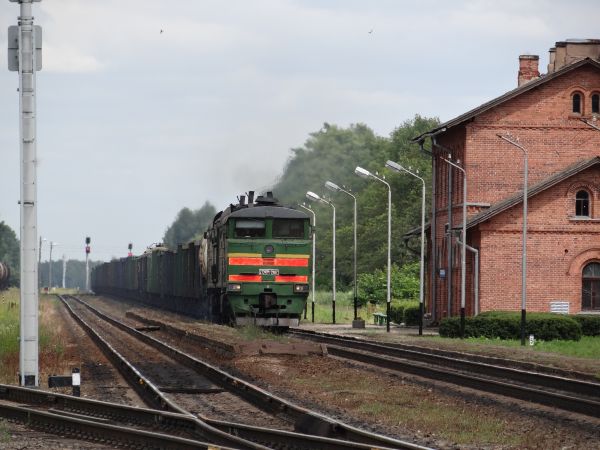
The 2TE10M giant with its train is coming closer. Picture in Naujene 27.6.2013 by Ilkka Siissalo.

...and when the machine gets really close the noise is incredible and you start realising how huge these machines are.
Picture in Naujene 27.6.2013 by Ilkka Siissalo.
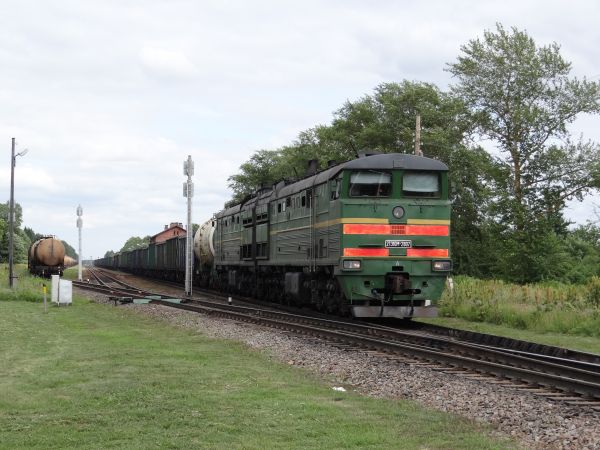
The 2TE10M was built in the USSR in Luhanskteplovoz and Malyshev factories from 1981 until present in over 2400 copies,
but the basic design dates back already to 1958. It is a 2x 6 axle double locomotive with a top speed of 100 km/h and it is
used only in Russia, Belarus, Ukraine and Latvia.
Picture in Naujene 27.6.2013 by Ilkka Siissalo.
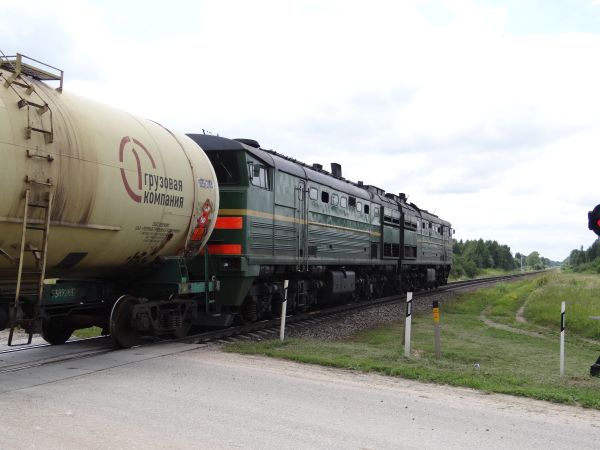
Standing by the side when a 2TE10M is running past is an ear deafening experience.
Picture in Naujene 27.6.2013 by Ilkka Siissalo.
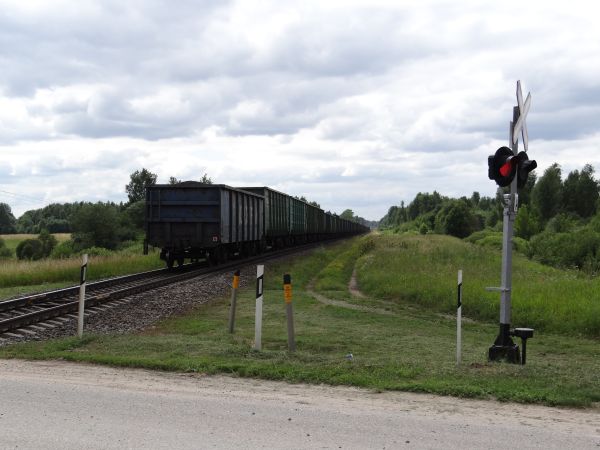
...and they also pull some pretty impressive trains, typically with some 45-50 four axle coaches. This one was loaded with coal.
Picture in Naujene 27.6.2013 by Ilkka Siissalo.
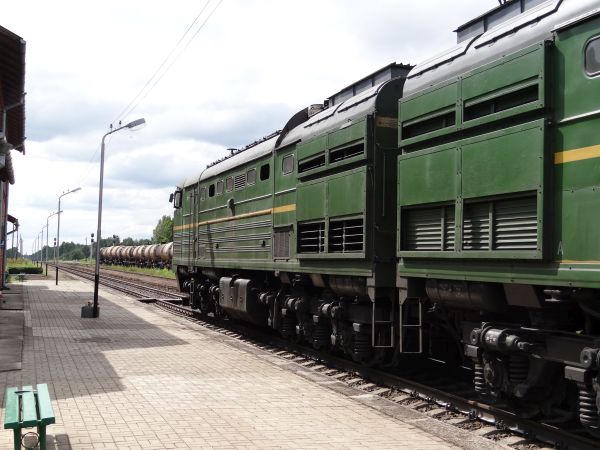
Side view of another Belarusian state railways 2TE10, this time the variant 2TE10MK, which has only been built in 20 copies.
Picture in Naujene 27.6.2013 by Ilkka Siissalo.
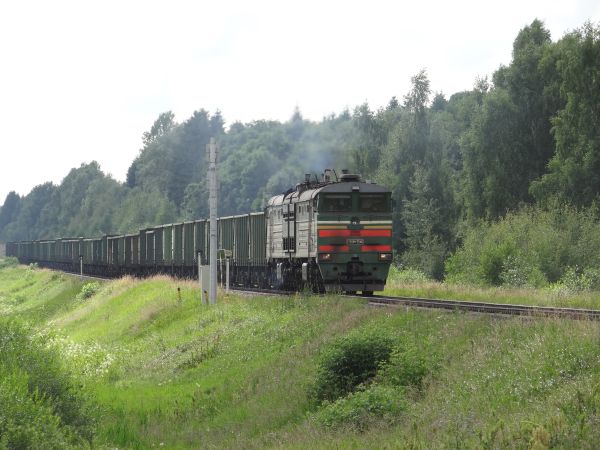
Yet another Belarusian 2TE10M, this time with an empty coal train with 48 four axle coaches.
Picture in Naujene 27.6.2013 by Ilkka Siissalo.

From this side it's easier to understand how huge the locomotive is.
Picture in Naujene 27.6.2013 by Ilkka Siissalo.
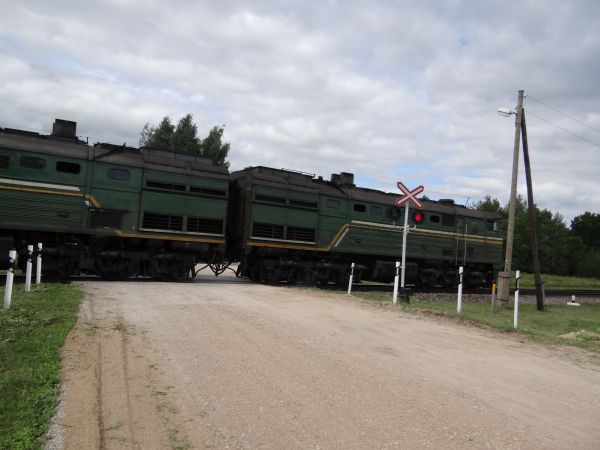
Sometimes it IS a good idea to stop in front of a red light. A Belarusian 2TE10M passing.
Picture in Naujene 27.6.2013 by Ilkka Siissalo.
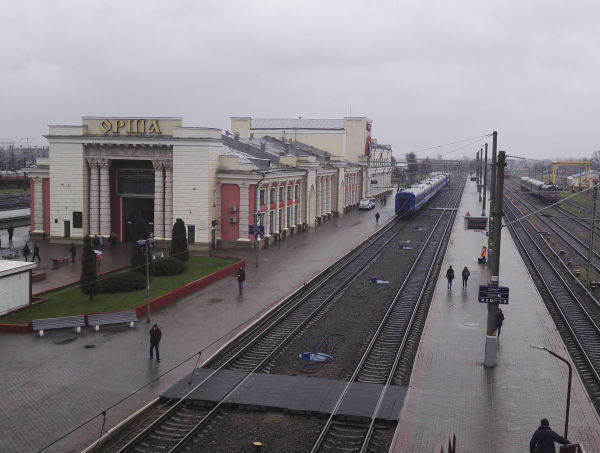
The station of Orsha in eastern Belarus. Picture 18.11.2017 by Markku Salo.
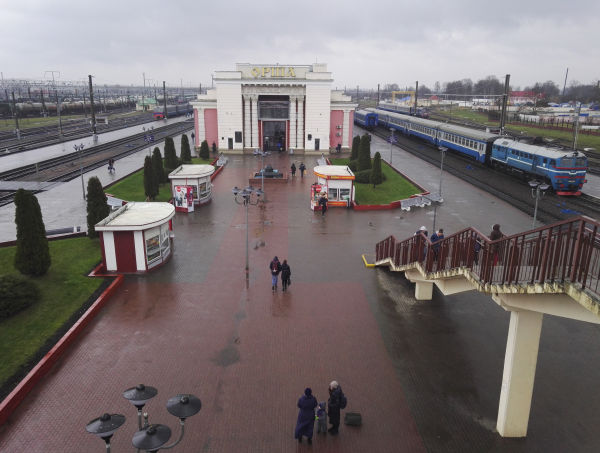
Another view of the station of Orsha in eastern Belarus. The two passenger trains on the right both have as their
locomotives one half of a double locomotive class 2M62U. Being just a half of a double locomotive, they both have only one
driver's cab. It's fairly common in Russia and the other ex-USSR states that double or triple locomotives are split
in pieces and used individually or in strange combinations with one another. Picture 18.11.2017 by Markku Salo.
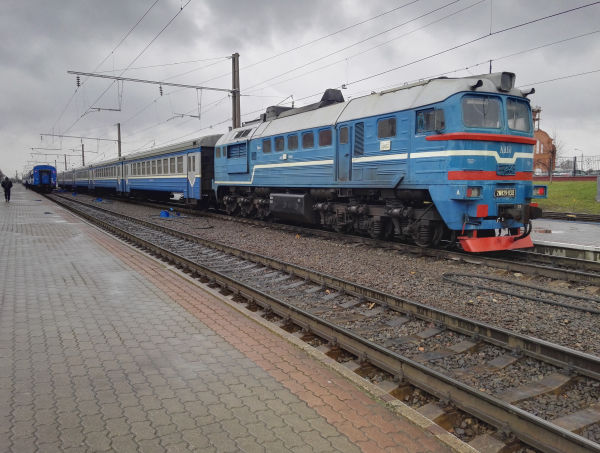
A closer view of one of the trains seen also in the picture above. The locomotive is one half of a 2M62U.
Picture in Orsha 18.11.2017 by Markku Salo.
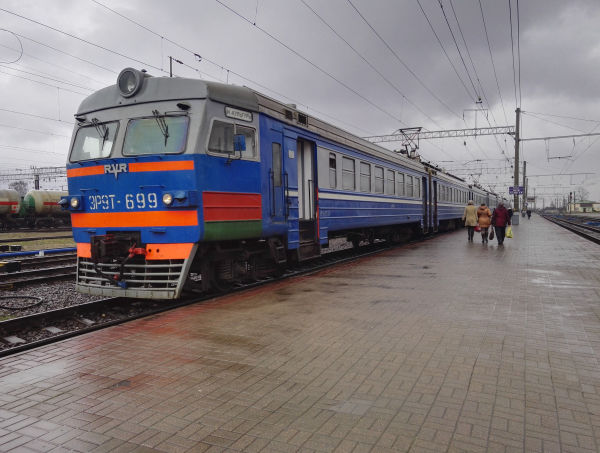
The regional/local electric multiple unit ER9T is built by RVR in Riga, Latvia. It is a modification of the very similar
ER2, but made for railroads with 25kV AC electric systems. They used to be very common throughout the ex-USSR. ER9T is
the newest variant of this type, produced in Riga since 1988. Compare with the ER2 and ER9 trains shown in our picture
categories Estonia, Latvia and Lithuania.
Picture in Orsha 18.11.2017 by Markku Salo.
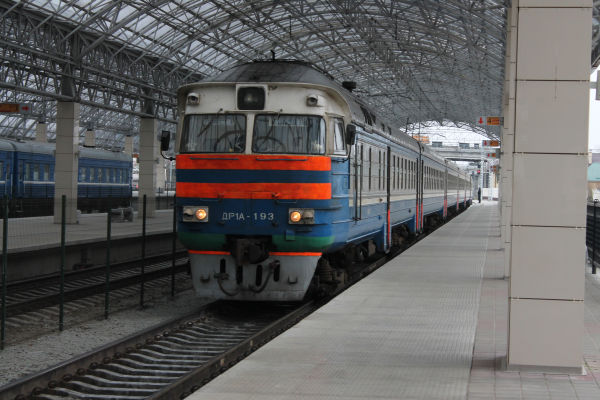
An old class DR1A diesel multiple unit built by RVR in Riga, Latvia. Picture from Brest 15.1.2018 by Timo Varshukov.
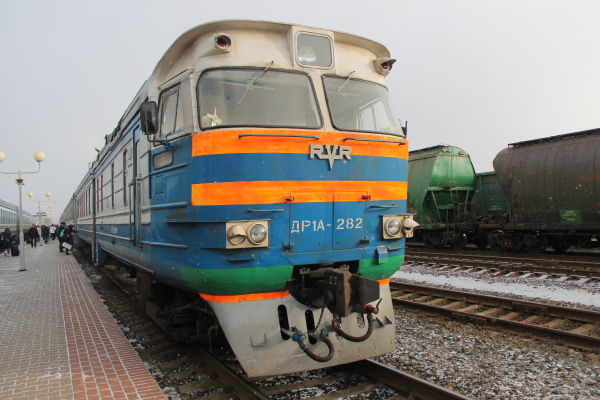
Another DR1A diesel multiple unit. These old trains are gradually getting rare. Picture from Slutsk 14.1.2018 by Timo Varshukov.
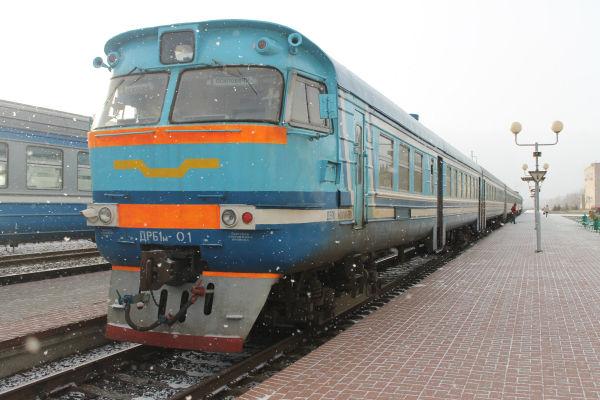
A DR1BM steering cab coach (M stands for modernised). Normally in a DR1B train there is a drivers cab coach like this one at one end and a similar
motorised wagon at the other end, but in this train only the steering cab coach and multiple middle coaches were used.
Picture from Slutsk 14.1.2018 by Timo Varshukov.

Same train as in the picture above. Instead of the usual DR1B motor wagon, at this end of the train there was one half of a class 2M62U
double locomotive.
Picture from Slutsk 14.1.2018 by Timo Varshukov.
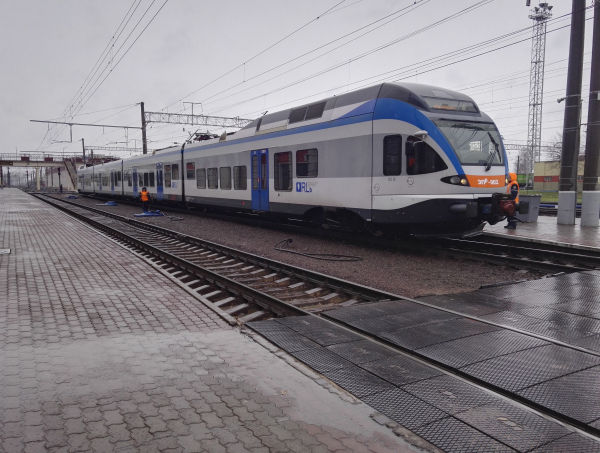
The Belarus state railways type EP superscript R is a product of the Swiss company Stadler. It is a broad gauge Stadler
FLIRT, very similar to the ones used in Finland and Estonia. The four coach train is 75,4 m long, has a top speed of
160 km/h and has 216 seats. Stadler signed their first contract with Belarus railways in 2010. The first order was 10
trains and later BC ordered 6 trains more.
Picture in Orsha 18.11.2017 by Markku Salo.

Inside view of a Belarusian Stadler FLIRT.
Picture in Orsha 18.11.2017 by Markku Salo.
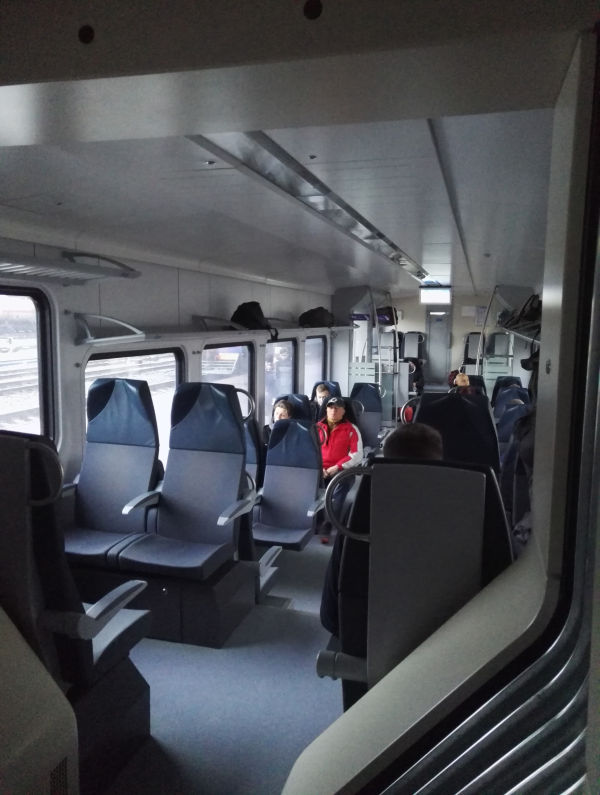
Another inside view of a Belarusian Stadler FLIRT. This shows nicely the low-floor part at the center of the coaches.
Picture in Orsha 18.11.2017 by Markku Salo.
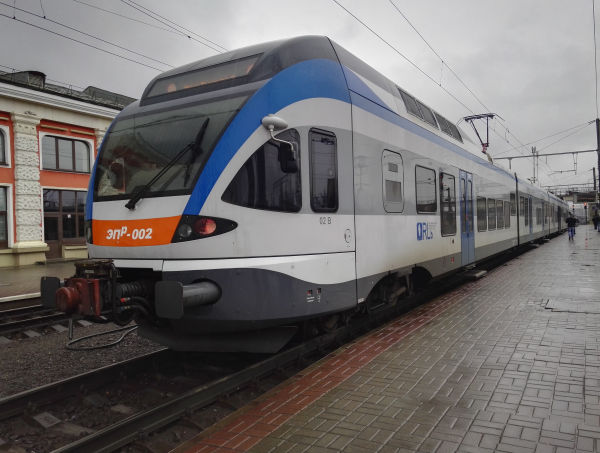
A closeup of a Belarusian FLIRT, class EP superscript R. They are almost identical to the FLIRT trains of Helsinki, Finland.
For comparison see our category of Finland.
Picture in Orsha 18.11.2017 by Markku Salo.
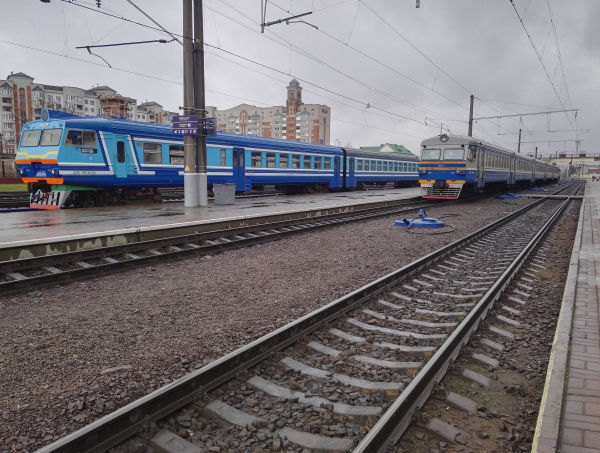
The train on the left is a diesel multiple unit of the class DR1B1 or DR1B1m of the depot in the city of Mogilev. They are
modernised trains of the class DR1 or DR1P built at RVR in Riga, Latvia. The train on the right is - judging by the different
colours typical of Estonia in the past -
a former class ER2 trainset from Estonian regional traffic around Tallinn. Estonian railways got rid of all of them when they
got new Stadler FLIRT trains to replace them. But since the ER2 is designed for 3000V DC and Belarus is using 25 kV AC, the
motor coach at the far end of the train has been replaced by a half of a double diesel 2M62 and this set consists of only the
unmotorised coaches of ER2 trains.
Picture in Orsha 18.11.2017 by Markku Salo.
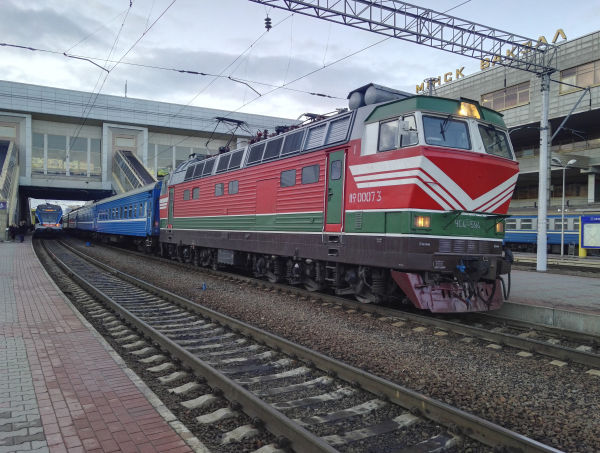
The huge six axle ChS4 superscript T is Belarus' biggest and most effective electric locomotive. They were built by Škoda
in Czechoslovakia in 1971-186. The type is used by Russian and Belarusian state railways. Its top speed is 180 km/h, power
rating is (only) 5100kW and it can only operate on 25 kV AC.
On the left one of the Stadler FLIRT trains of the class EP superscript R.
Picture from Minsk main station 18.11.2017 by Markku Salo.
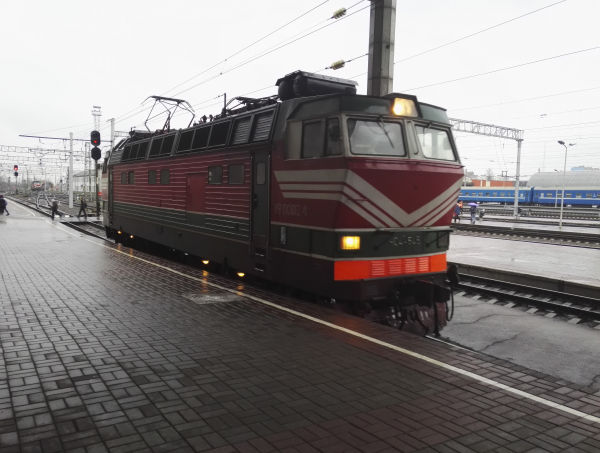
A CHS4T is backing to fetch a rake of passenger train coaches at the Minsk main station. Note that one of the lower headlights
has been deliberately covered at what is to be the back end of the locomotive.
Picture from Minsk main station 18.11.2017 by Markku Salo.
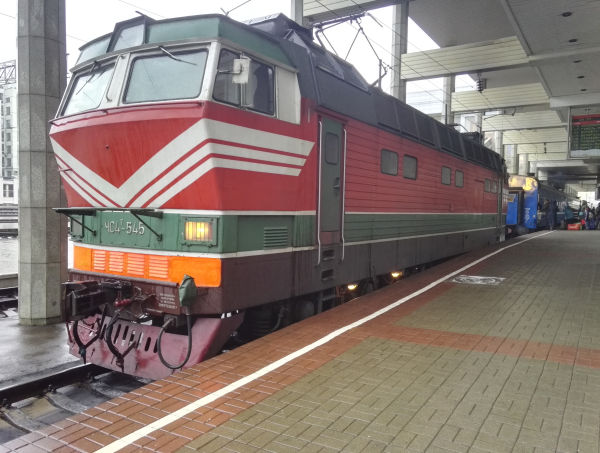
A CHS4T is backing to fetch a rake of passenger train coaches at the Minsk main station and has now almost reached the rake
of coaches. Note that this side of the locomotive is still momentarily the back side, so only one lower headlight is on.
Picture from Minsk main station 18.11.2017 by Markku Salo.
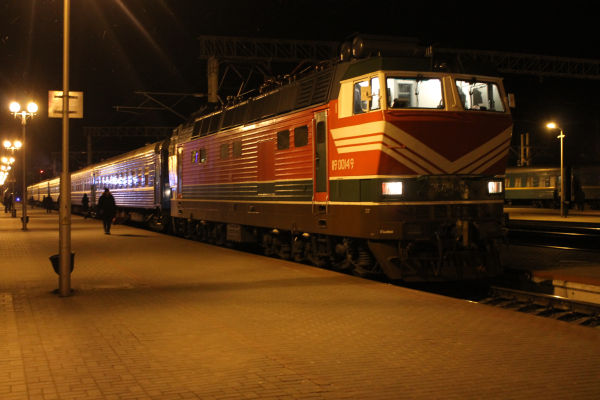
Another CHS4T, no. 0014 is stopping in front of a nightly train at the station of Zhlobin.
Picture 4.3.2018 by Timo Varshukov.
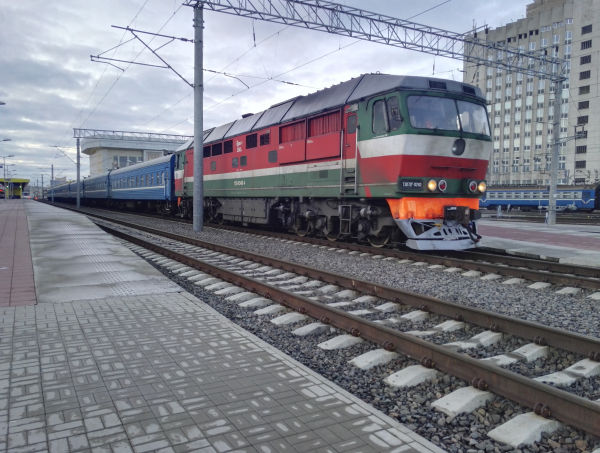
The diesel locomotive type TEP70 superscript K was built by the Kolomna Locomotive Works KTZ in the years 1973 to 2006 (!!).
It is a 160 km/h fast passenger train diesel with six axles, 135 tons of mass and a power rating of 2250 kW. The superscript
letter K means that the machine has been refurbished by DLRR. The type is in use in Russia as well.
Picture from Minsk main station 18.11.2017 by Markku Salo.
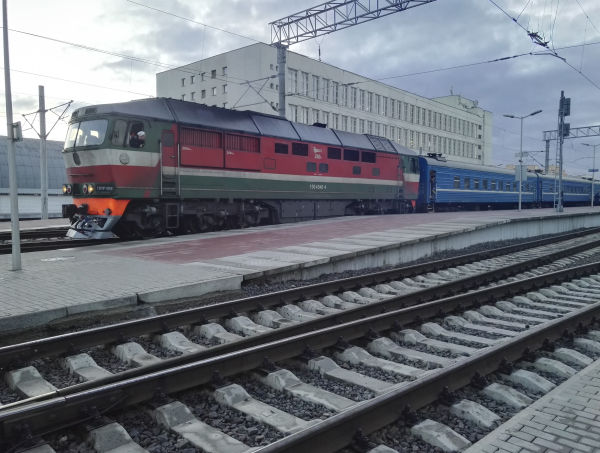
Another view of the diesel locomotive type TEP70 superscript K.
Picture from Minsk main station 18.11.2017 by Markku Salo.
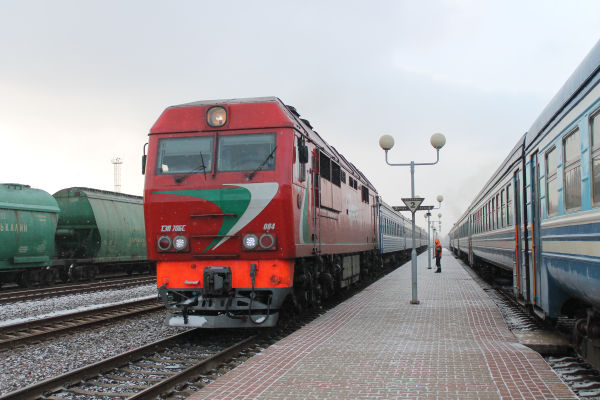
The TEP70BS is a newer and improved version of the famous TEP70 locomotive. These are built by Transmashholding in Russia for passenger
traffic and they are used by the October, South Eastern, Kaliningrad, Gorky, Privolzhsk, Far East and North Caucasian Railways branches
of the Russian Railway RZD as well as in Belarus, Lithuania and Uzbekistan. This is of course the Belarusian livery.
Picture from Slutsk 14.1.2018 by Timo Varshukov.
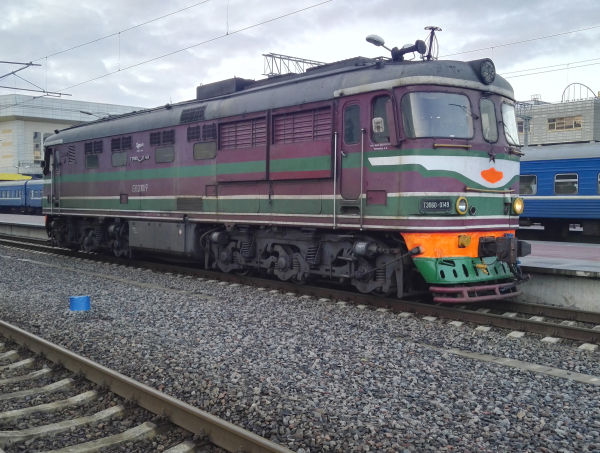
The passenger train diesel type TEP60 used to be commonplace throughout the whole former USSR, but nowadays it is really
something to see one of them in day to day use. A couple of examples can be seen at railway museums for example in the Baltic
states. After the Baltics joined the EU, enthusiastic train photographers travelled to Riga and Kaunas just for the opportunity
to photograph this nice looking machine in real use, but even that traffic has now been switched to more modern types.
TEP60 was produced by the Kolomna Locomotive Works at Kolomna, Moscow oblast, Russia. TEP60 was produced 1960-1985 (!) in
1472 copies (!!). In addition to that, 116 of the double locomotive type 2TEP60 were made. Its top speed is 160 km/h, power
rating is 2205 kW and weight is 129 tons. It has two V-16 turbodiesel engines.
Picture from Minsk main station 18.11.2017 by Markku Salo.
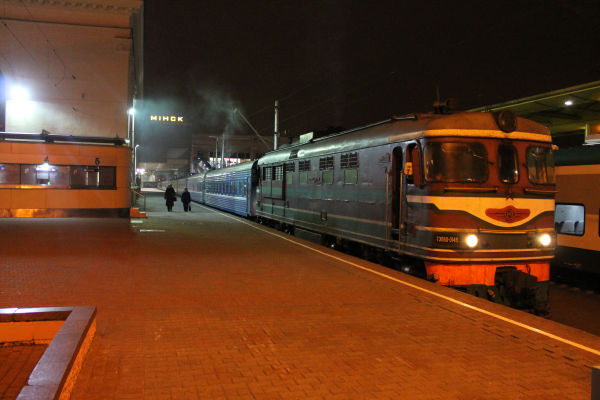
The same TEP-60 no. 149 at Minsk station still in full use 18.1.2018. Picture by Timo Varshukov.
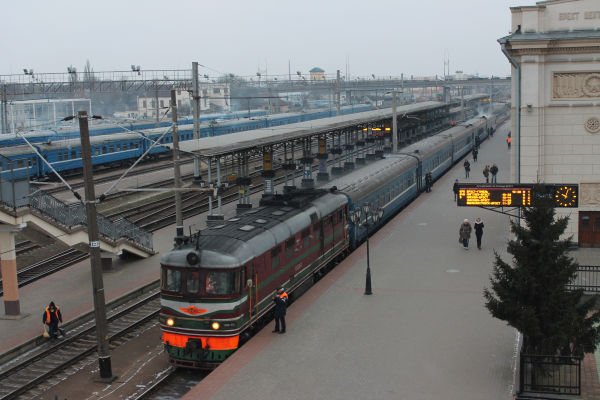
Another TEP-60 no. 151 by the border at Brest station. Picture 15.1.2018 by Timo Varshukov.
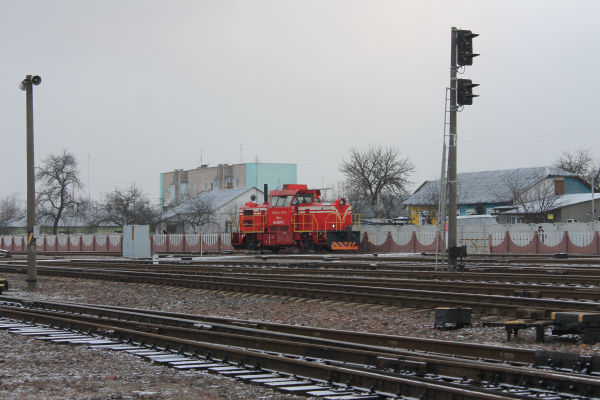
The shunter locomotive TME3 is a brand new type designed jointly by the Belarusian railways and CZ Loko of Czech Republic.
It has a power rating of 403 kW and a top speed of 60 km/h. It weighs 46 tons. These new machines cost about 1,35 million
euros a piece and compared with older shunters they save so much fuel that their payback time is 8 years - much shorter than
for most locomotives.
Picture from Slutsk 14.1.2018 by Timo Varshukov.

